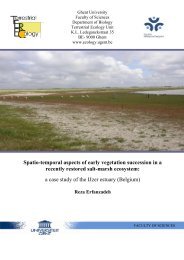PhD Arthur Decae 2010 - Ghent Ecology - Universiteit Gent
PhD Arthur Decae 2010 - Ghent Ecology - Universiteit Gent
PhD Arthur Decae 2010 - Ghent Ecology - Universiteit Gent
You also want an ePaper? Increase the reach of your titles
YUMPU automatically turns print PDFs into web optimized ePapers that Google loves.
Figs. 40-46: Nemesia santeugenia sp. n., female. 40 habitus dorsal; 41 habitus ventral; 42 carapace lateral;<br />
43 eye-formation, dorsal; 44 patella and tibia III, prolateral; 45 spinnerets, ventral; 46 spermathecae, dorsal.<br />
Scale line = 2mm (40-42), 1mm (43-46).<br />
prolateral proximal edge. Sternum centrally lighter brown than along edges, similar shading<br />
as ventrally on coxae, evenly covered with setae of varying size, anterior and median sigilla<br />
round and marginal, posterior sigilla oval and sub-marginal (about their largest diameter from<br />
sternum edge). Labium more greyish than sternum, dome-shaped, wider than long, even1y<br />
covered with fine setae proxirmally and stronger setae distally. Labial furrow wide, glabrous,<br />
co1our as sternum edge. Abdomen brownish grey with complex dorsal-latera1 pattern of<br />
brownish patches and chevrons. Spinnerets (Fig. 45) same color as ventral abdomen, PMS<br />
reduced, spiky, with few apica1 spigots, PLS basa1 segment with few fine spigots near<br />
ventral-dista1 edge, apica1 spigots evenly distributed around four macro-spigots.<br />
Spermathecae (Fig. 46) unipartite, compact, a1most as broad as long, "potato-shaped", with<br />
dense cover of glandular tissue.<br />
Variation (n=2): BL = 15-23.5, CL = 5.9-8.2. Carapace, CL/CW = 1.3-1.5, CL/Ca = 1.6.<br />
Caput Ch/Th = 1.9-2.2. Clyp = 0.19-0.27. Eye-formation: AR/PR = 0.99- 1.02, AR/El = 2.00-<br />
2.06, ALE/PLE = 1.21-1.41. Male: Unknown.<br />
Burrow (Fig. 71): Nemesia santeugenia inhabits a typica1 "branched wafer-door burrow".<br />
The burrows were found in relatively soft sandy soils on gently sloping surfaces covered with<br />
debris of conifer needles, fallen leaves, bits of grasses and moss. The thin, flexible trapdoor<br />
(wafer door; Moggridge, 1873, 1874) is camouflaged by spun-in debris from the surrounding<br />
surface and 1oosely closes the burrow entrance by falling over the entrance opening. The










